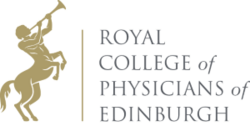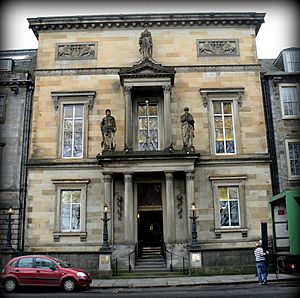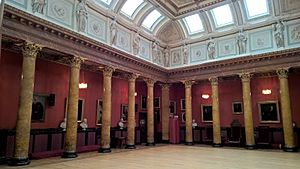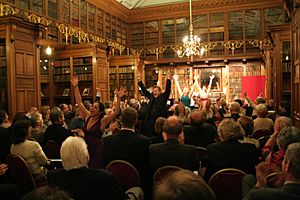Royal College of Physicians of Edinburgh facts for kids
The Royal College of Physicians of Edinburgh (RCPE) is a special group for doctors in Scotland. It is one of three groups that help set the rules for how doctors are trained in the United Kingdom. The college was officially started by a special paper from the King or Queen, called a Royal charter, in 1681. Today, the RCPE has more than 14,000 members and experts from all over the world.
Contents
History of the RCPE
The RCPE was created thanks to a royal charter in 1681. Sir Robert Sibbald played a big part in making this happen. Before this, they tried three times to get the charter, but it didn't work.
There were 21 original members, called Fellows. Many of them had studied at the University of Leiden. In 1920, the college made an important change. They started allowing women to join on the same rules as men. The college's charter was updated again in 2005.
Edinburgh's First Medical Book
In 1699, the college published its first medical guide. This book had standard recipes for medicines. It was called Pharmacopoea Colegi Regii Medicorum Edimburgensium.
This guide, known as the Edinburgh Pharmacopoeia, was printed 13 times. The last edition came out in 1841. After that, a new book called the British Pharmacopoeia took its place.
College Buildings Over Time
The RCPE has had several homes in Edinburgh. In 1704, they bought a house and land in the Old Town. This was on Fountain Close, near the Cowgate.
George Street Hall
Later, in 1775, they started building a new hall and library. This was on George Street in the New Town. The architect was James Craig.
The building was very expensive to finish. The college ran out of money for the inside. Because of the high cost, they had to sell this hall in 1841. It was then torn down.
For a few years, from 1843 to 1846, the college didn't own a meeting place. They rented a space on George Street instead.
Queen Street Hall
A new hall was started at 9 Queen Street in 1844. This building was designed by Thomas Hamilton. The Queen Street Hall was finished in 1846.
The building next door, Number 8 Queen Street, was built much earlier. It was designed by Robert Adam around 1770. The college bought it in 1868. After a big repair project, it was fully restored in 1997.
The college also bought Numbers 11 and 12 Queen Street. These buildings were built around 1780. Number 11 now has a Conference Centre. Number 12 has meeting rooms and offices.
In 1984, the college sold a painting by Richard Dadd. This was done to raise money to fix a problem with dry rot in the buildings.
Sibbald Library
In 1682, Robert Sibbald gave about 100 books to the college. The college's library at Queen Street is named after him. It holds many old and important books.
The library also has interesting items. For example, it has a medicine chest that belonged to Stuart Threipland. He was a doctor for Bonnie Prince Charlie.
In the 1960s, the library had a lot of modern medical information. But as medical information became easier to find elsewhere, the library became known for its historical books.
In 2015, the college worked with the University of Glasgow. They made 5,000 letters from William Cullen available online. These letters are from the mid-1750s to 1790.
As of 2016, the college has catalogued over 30,000 records in its archives.
College Laboratory
In 1888, the college decided to open its own research lab. They first rented a house near the Royal Infirmary. Later, they got a three-story building on Forest Road.
This new lab opened in 1896. It had special areas for different studies. These included Bacteriological, Chemical, and Histological and Experimental research. The lab closed in 1950.
How to Become a Member
Doctors can become Members of the college. They do this after passing special exams. These exams are called the MRCP(UK) or MRCPCH examinations.






